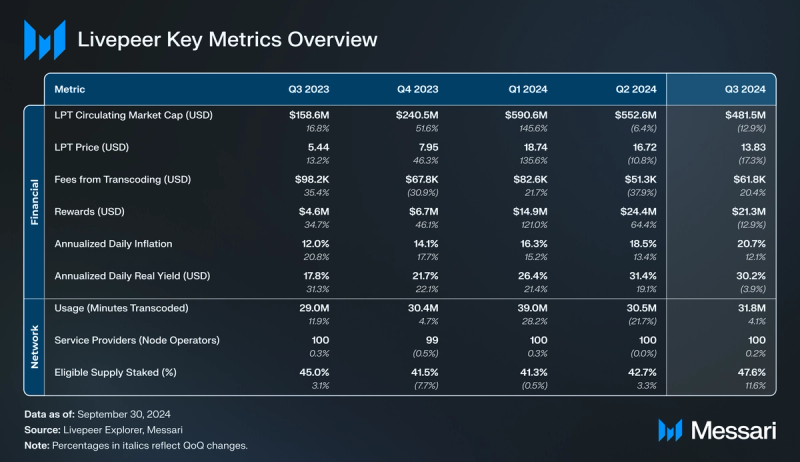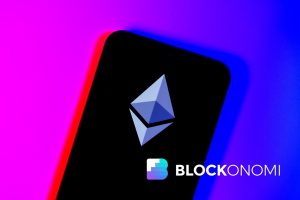Key Insights
- In Q3’24, video transcoding usage on the Livepeer network increased 4% QoQ, as demand-side transcoding fees increased 20% QoQ.
- The Livepeer AI Subnet was introduced for AI-powered video processing and is expected to further drive demand while introducing new revenue streams. Fees from Livepeer AI reached nearly 24% of the transcoding fees in Q3’24.
- Staking rewards decreased 13% QoQ in USD, driven by a 17% QoQ drawdown in LPT price. LPT annualized daily issuance grew 12% QoQ and reached 20.7% in Q3’24.
- In Q3’24, Livepeer contributed to the creator economy, notably with the launch of Ample Protocol for decentralized content moderation and the Gen tool for AI-powered content generation.
Primer
Building decentralized video apps like Twitch or TikTok requires live and on-demand video streaming infrastructure. Based on a user’s bandwidth and device, video content needs to be processed — i.e., transcoded — into viewable formats. While cloud providers like AWS, Google, or Microsoft are commonplace solutions for video transcoding, they incur high costs.
The Livepeer network offers an open and permissionless video infrastructure marketplace for live and on-demand streaming. Livepeer’s transcoding marketplace allows anyone to contribute compute resources (e.g., GPUs) and to compete on price. The network is designed to reduce transcoding costs for end users by up to 10x.
Within Livepeer’s decentralized transcoding network, there are three key participants:
- Node operators — called “Orchestrators” — route transcoding jobs. The amount of work a node operator can perform is proportional to how many Livepeer native tokens (LPT) it stakes. Node operators earn ETH fees and newly minted LPT rewards.
- Service nodes — called “Transcoders” — provide compute resources for node operators and deliver video transcoding. In return, they earn ETH fees. Typically, Orchestrators and Transcoders run within the same machine (combined setup).
- Delegators stake LPT towards effective node operators to help secure the Livepeer network. Staking is rewarded with a portion of both ETH fees and LPT rewards.
Beyond transcoding, Livepeer introduced an AI Subnet for video generation capabilities (e.g., text-to-image, text-to-video, and image-to-video) used in entertainment, social media, and gaming. The LPT token has recently been included in the Grayscale Decentralized AI Fund, which consists of native tokens of decentralized AI protocols.
Website / X (Twitter) / Discord
Key Metrics
Performance Analysis
Demand for Livepeer services comes from apps and developers needing video transcoding, live-streaming, and video generation capabilities. For example, decentralized social media (DeSoc) apps, traditional Web2 apps (like TikTok or Twitch), or music streaming apps (like Spotify or SoundCloud) require streaming infrastructure to broadcast video content.
Network
Livepeer’s network usage can be gauged by estimating the number of minutes of video transcoded. In September 2023, Livepeer announced a change in the methodology for estimating its usage. This change addressed challenges in estimating the number of transcoded minutes, given that this metric is not directly observable onchain.
While the previous methodology relied on transcoding fees earned by node operators as a proxy for usage, the updated methodology accounts for changes in usage patterns, such as the introduction of video-on-demand (VOD) transcoding and varying price points. As the usage metric is acknowledged as imperfect but valuable, the previous data is retained until September 2023, when the change was implemented.
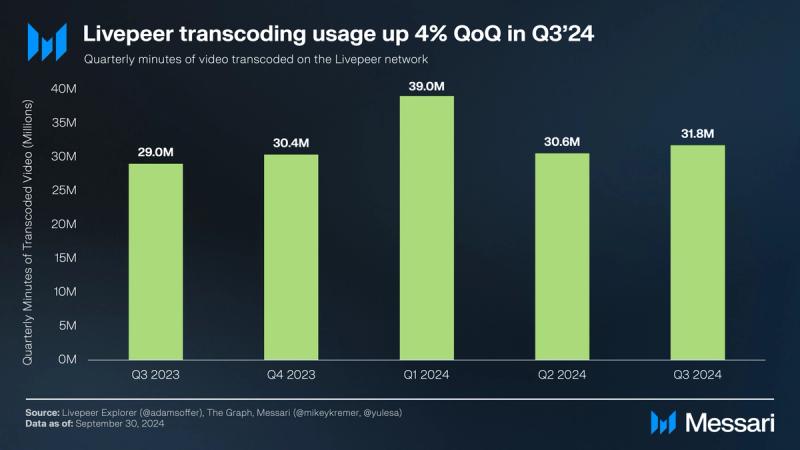
The usage of the Livepeer transcoding network increased by 4% QoQ. Nearly 32 million minutes of video were transcoded in Q3’24, up from nearly 31 million in Q2’24. Notably, Fishtank, an interactive streaming platform leveraging Livepeer Studio’s decentralized video streaming, reached one million viewers and generated $3 million in revenue in August 2024. This example showcases the potential of cost-effective, high-quality streaming solutions for niche content creators in the digital entertainment space.
Simultaneously, the Livepeer network has started to capitalize on its AI video compute capabilities, such as text-to-image, text-to-video, and image-to-video capabilities. To this end, the team introduced the Livepeer AI Subnet for decentralized AI media processing marketplaces and tools.
Financials
Fees from Transcoding
Demand-side fees are paid in ETH fees by services using the Livepeer network. Transcoding fees are accrued by node operators and further distributed to transcoders and delegators. Node operators with larger amounts of stake are more likely to receive more transcoding work, subsequently earning more transcoding fees.
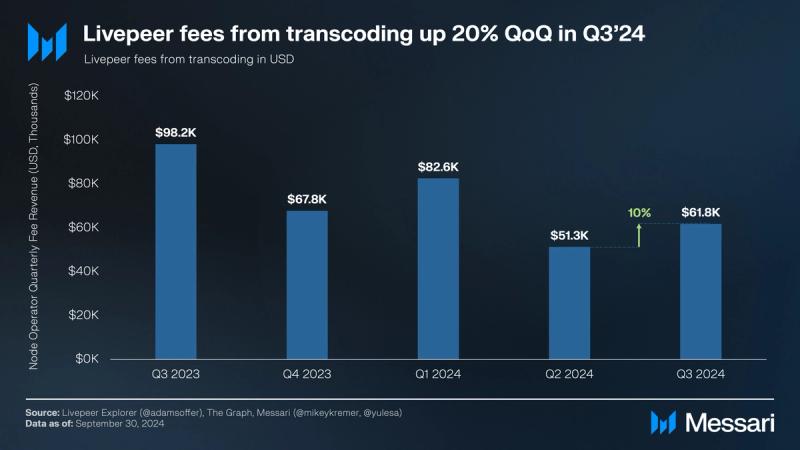
Livepeer demand-side fees from transcoding increased 20% QoQ in USD terms, in line with usage growth. With the live-streaming market growing 20% YoY, Livepeer aims to continue reducing the cost of streaming solutions for end users by up to 10x.
Fees from AI Subnet
As per Messari’s report and with the recent launch of the AI Subnet, Livepeer started to support AI video generation using the network’s compute power (e.g., GPUs). This represents a major step as the network introduces its first job types beyond transcoding, on its path to addressing the entire video and media compute infrastructure market.
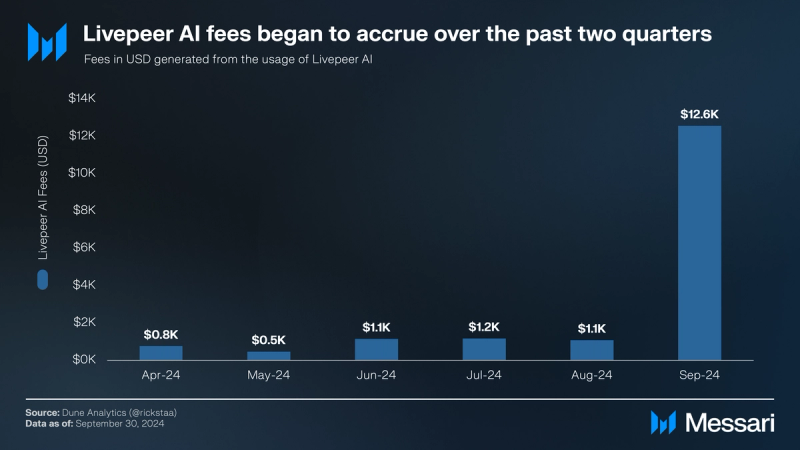
Node operators recently started accruing ETH fees for performing AI video generation. In Q3’24, nearly $15,000 in fees were generated from using Livepeer AI, representing 24% of the transcoding fees accrued by the Livepeer network in Q3’24. The Livepeer AI Subnet is expected to further drive demand for the network’s compute resources while introducing additional revenue streams.
Staking Rewards
The Livepeer network distributes staking rewards in LPT to node operators and delegators. To provide video services on the Livepeer network, node operators must stake LPT. A node operator’s stake weight comprises their own tokens and those delegated towards them.
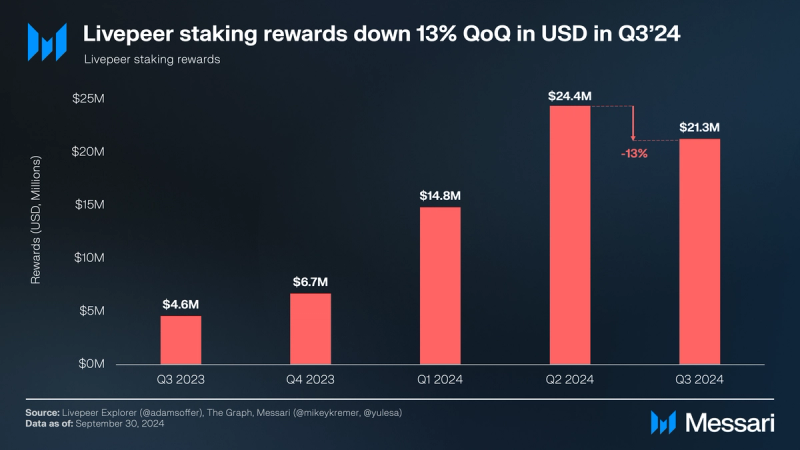
Staking rewards decreased 13% QoQ in USD terms, driven by a 17% QoQ drawdown in LPT price. LPT annualized daily issuance grew 12% QoQ and reached 20.7% in Q3’24. This increase in LPT issuance corresponded to the staking participation continuing to stay below the 50% target equilibrium level. Implications are discussed in the section below.
Staking Participation
The LPT token follows the Stake-for-Access (SFA) model, also known as a work token model. That is, Livepeer requires its node operators to stake LPT to perform work on the network. The past seven quarters saw Livepeer staking participation — the percentage of the circulating LPT supply that is staked — stay below the 50% target level. Simultaneously, delegators on the Livepeer network decreased to nearly 3,400 Q3’24, down from over 4,300 in Q1’23.
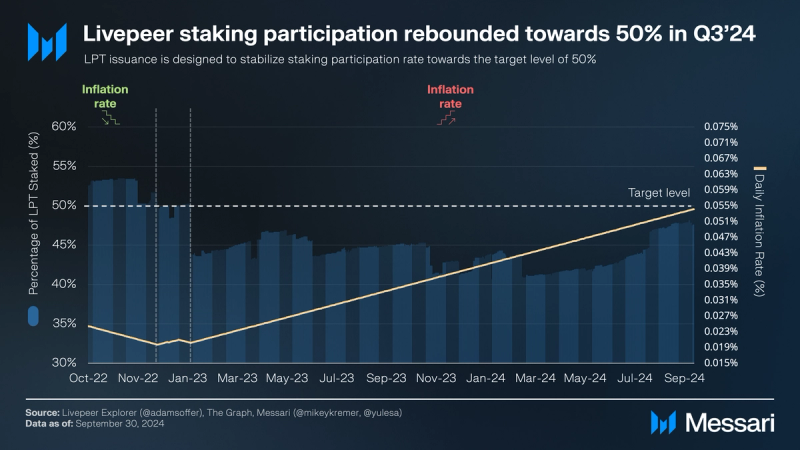
Daily LPT issuance steadily increased from 0.02% in January 2023 to above 0.05% by the end of September 2024. Though the staking participation rate increased to nearly 48% in Q3’24, it remained below the 50% equilibrium threshold. For context, the dynamic LPT issuance in absolute terms follows the staking participation rate as below:
- When the participation rate falls below 50%, LPT issuance increases by 0.00005%.
- Conversely, when the participation rate passes 50%, LPT issuance drops by 0.00005%.
An explanation for the staking participation staying below the 50% threshold is the incentive decoupling between staking and transcoding. Previous research found that the top five node operators by LPT staked earned roughly 40-50% of staking rewards but only ~20% of all transcoding fees. With the introduction of the AI Subnet, staking participation has increased steadily and it remains to be seen whether it will reach the target equilibrium level of 50% over the next quarters.
Qualitative Analysis
Key Developments
AI Subnet and Expanded Capabilities
A notable development in Livepeer’s AI integration efforts in Q3’24 was the launch of the AI Subnet, which expands the network’s AI video capabilities. This infrastructure allows node operators on the Livepeer network to earn fees through AI inference jobs, creating a new revenue stream within the Livepeer ecosystem. Currently, 27 AI node operators are processing AI jobs such as text-to-image, image-to-image, and image-to-video tasks. The AI Subnet’s capabilities expanded throughout the quarter, incorporating features such as: speech-to-text via Whisper, support for Stable Diffusion 3, and customization options for generative AI-powered media outputs. These additions expand the range of AI-powered services Livepeer offers and enhance the generated content’s quality and versatility.
Key Events
FlipGuard Collaboration
Livepeer collaborated with FlipGuard, a startup from the AI Video Startup Program, to develop the Gen tool. Powered by Livepeer AI, this tool allows users to generate custom images within chat interfaces. Gen enables users to visually express their moods, thoughts, and ideas in real-time conversations. This development demonstrates practical applications of Livepeer’s AI technology in enhancing user experiences across digital platforms.
Fishtank Collaboration
A successful development in Q3’24 has been the collaboration between Livepeer Studio and Fishtank, an interactive streaming platform. Fishtank reached one million viewers and generated $3 million in revenue, which it attributes largely to its partnership with Livepeer Studio. This collaboration demonstrates the practical applications and market potential of Livepeer’s decentralized video infrastructure.
Livepeer Studio’s open-source platform has contributed to Fishtank’s growth, reducing operational costs compared to traditional cloud services. This cost-effectiveness, combined with high-quality streaming capabilities, has created an environment that may benefit niche content creators in the interactive live content space.
Ample Protocol Launch
Further expanding its ecosystem, Livepeer saw the launch of Ample Protocol, a dApp designed to enhance how creators monetize their digital assets. The platform enables content creators to manage and monetize their onchain intellectual property (IP) and NFTs.
Ample Protocol’s integration with Livepeer Studio for content hosting and token gating demonstrates Livepeer’s expanding role in the creator economy. This collaboration aims to give creators increased control over their content distribution and monetization strategies.
Key Governance
Treasury Proposals
In an attempt to expand Livepeer’s capabilities, Livepeer introduced a series of successful treasury proposals in August 2024:
- Livepeer LLM SPE: introducing Large Language Model (LLM) capabilities to the Livepeer network, expanding its AI offerings beyond video and media. The LLM SPE aims to oversee development and implementation and will issue a quarterly written report on progress.
- Live Pioneers Wave 2: aiming to expand content into eight new languages, provide educational resources, and support the onboarding of long-term delegators.
- Livepeer.Cloud SPE is providing $153,000 as funding to implement an AI Job Tester and Livepeer Explorer AI Performance Leaderboard, which will, among other things, help display the top-performing Orchestrators running on the AI subnet.
AI Video Startup Program
The AI Video Startup Program, funded by Livepeer’s Grants Program, supports startups developing decentralized AI video technologies and apps. The program offers selected startups up to $20,000 in grant funding, infrastructure credits, and mentorship from the Livepeer team.
Closing Summary
Video transcoding usage on the Livepeer network increased 4% QoQ, as demand-side transcoding fees increased 20% QoQ. Notably, Fishtank, an interactive streaming platform leveraging Livepeer Studio’s decentralized video streaming, reached one million viewers and generated $3 million in revenue in August 2024. This example showcases the potential of cost-effective, high-quality streaming solutions for niche content creators in the digital entertainment space.
Beyond transcoding, the Livepeer team introduced an AI Subnet for text-to-image, text-to-video, and image-to-video capabilities used across entertainment, social media, and gaming. The Livepeer AI Subnet is expected to further drive demand while introducing new revenue streams. Fees from Livepeer AI reached nearly 24% of the transcoding fees in Q3’24.
In Q3’24, Livepeer contributed to the creator economy, notably with the launch of Ample Protocol for decentralized content moderation and the Gen tool for AI-powered content generation.

